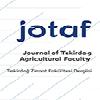Preliminary Checking of Some Turkish Diatomaceous Earth Similarities with Commercial Diatomaceous Earths under Scanning Electron Microscope (SEM)
___
Anonymous, 2017a. Diatomite Mining and Processing,http://diatomite.org/DiatomiteMining-and-Processing.IDPA, International diatomite producers association. (Accessed date: 05.05.2017).Anonymous, 2017b. Scanning Electron Microscopy (SEM). https://en.wikipedia.org/wiki/Scanningelectro nmicroscope (Accessed date: 05.05.2017).
Athanassiou, C.G., B.J. Vayias, C.B. Dimizas, N.G. Kavallieratos, A.S. Papagregoriou and C.Th. Buchelos, 2005. Insecticidal efficacy of diatomaceous earth against Sitophilus oryzae (L.) (Coleoptera: Curculionidae) and Tribolium confusum du Val (Coleoptera: Tenebrionidae) on stored wheat: influence of dose rate, temperature and exposure interval. Journal of Stored Products Research, : 41- 47.
Athanassiou, C.G., N.G. Kavallieratos, B.J. Vayias, Z. TomanoviC, A. Petrovic, V. Rozman, C. Adler, Z. Korunic and D. Milovanovic, 2011. Laboratory evaluation of diatomaceous earth deposits mined from several locations in central and southeastern Europe as potential protectants against coleopteran grain pests. Crop protection 30: 329-339.
Bhishma, R.S., S.H. Alavi, S.P. Harimkar, M. McCollum, J.F. Donoghue and F.D. Blum, 2017. Particle morphology dependent superhydrophobicity in treated diatomaceous earth/ polystyrene coatings, Applied Surface Science 416:947-956.
Calvert, R. 1930. Diatomaceous earth Journal of Chemical Education, 7: 28-29.
Çetin, M. and B. Taş, 2012. Biyolojik orjinli tek mineral: Diyatomit. Türk Bilim Araştırma Vakfı (TÜBAV) Bilim Dergisi, 5(2): 28-46.
Parkinson, J. and R. Gordon, 1999. Beyond micromachining: the potential of diatoms. Trends Biotechnology, 17:190-196.
Round, F., R. Crawford and D. Mann, 1990. The Diatoms: Biology and Morphology of the Genera, Cambridge University Press, UK.
Katz, H. 1991. Desiccants: dry as dust means insect's death. Pest Control Technology, 82-84.
Korunic, Z., P.G. Fields, M.I.P. Kovacs, J.S. Noll, O.M. Lukow, C.J. Demianyk and K.J. Shibley, 1996. The effect of diatomaceous earth on grain quality. Postharvest Biology and Technology, 9(3): 373-387.
Korunic, Z. 1997. Rapid assessment of the insecticidal value of diatomaceous earths without conducting bioassays. Journal of Stored Products Research, 33, 219-229.
Korunic, Z. 1998. Diatomaceous earths, a group of natural insecticides. Journal of Stored Products Research, 34: 87-97.
Doğanay, İ.Ş. , A.A. Işıkber, Ö. Sağlam and Y. Bilgili, 2014. Efficiency of some Turkish diatomaceous earth deposits against stored-grain insects, Sitophilus granarius (L.) and Rhyzopertha dominica (F.). International Conference on Biopesticide (ICOP 7), p.91.
Ertürk, S. 2014. Farklı diyatom toprağı formülasyonlarının depolanmış çeltikte zararlı böceklere etkinliği üzerinde araştırmalar. Ankara Üniversitesi, Fen bilimleri Enstitüsü, Bitki Koruma Anabilim Dalı, Doktora Tezi, s.120.
FDA (Food and Drug Administration, USA), 1995. Specifications for diatomaceous earths as a maximum 2 % animal feed additive. 21 CFR Section, 573.340.
Işıkber, A.A., Ö. Sağlam, M.K. Er and H. Tunaz, 2016. Potential of Turkish diatomaceous earth formulations as natural grain protectants for control of stored grain insects. 15 th International Cereal and Bread Congress, p.42.
Işıkber, A.A., Ö. Sağlam, M.K. Er, H. Tunaz and R. Şen, 2015. Toxicity of Turkish diatomaceous earth deposits against some stored-grain insects on wheat. 10th Conference of IOBC/WPRS Working Group "Integrated Protection of Stored Products" Congress, p.29.
McLaughlin, A. 1994. Laboratory trials on desiccant dust insecticides. 6th InternationalWorking Conference on Stored-Product Protection. CAB, Wallingford, Canberra, Australia, pp. 638-645.
Mete, Z. 1998. Kütahya-Alayunt Yöresi Diyatomit Yataklarının Zenginleştirilmesi, Akdeniz Üniversitesi Isparta. Mühendislik Fakültesi Dergisi, 184-201.
Özbey, G. and N. Atamer, 1987. Kizelgur (Diatomit) hakkında bazı bilgiler. 10. Türkiye Madencilik Bilimsel Teknik Kongresi, Ankara, s.493-502.
Round, F., R. Crawford and D. Mann, 1990. The Diatoms: Biology and Morphology of the Genera, Cambridge University Press, UK.
Sıvacı, R. and Ş. Dere, 2006. Melendiz Çayı'nın (Aksaray-Ihlara) Epipelik Diyatome Florasının Mevsimsel Değişimi. C.Ü. Fen-Edebiyat Fakültesi Fen Bilimleri Dergisi, 27(1): 1-12.
Snetsinger, R. 1988. Report on Shellshock insecticide. Report of Department of Entomology, Pennsylvania State University, pp. 1-7.
Subramanyam, B. and R. Roesli, 2000. Inert dust. In Subramanyam Bh, Hagstrum, D.W. (Eds), Alternatives to Pesticides in Stored - Product IPM. Kluwer Academic Publishers, Boston, MA: p.321-379.
- ISSN: 1302-7050
- Yayın Aralığı: 3
- Başlangıç: 2004
- Yayıncı: Namık Kemal Üniv. Tekirdağ Ziraat Fak.
Hristo STOYANOV, Valentin BAYCHEV, Gallina MIHOVA
Seasonal Variation of the Nutrient Contents of Sarcopoterium spinosum (L.) Spach
Ahmet GÖKKUŞ, Fırat ALATÜRK, Baboo ALİ, Volkan ÇOBAN
Collembola Communities in Different Compost Types as Bioindicator of Substrate Quality
Lilyana KOLEVA, Milena YORDANOVA, Georgi DIMITROV
Vine and Berry Responses to Severe Water Stress in Different Stages in cv Syrah (Vitis vinifera L.)
ELMAN BAHAR, Alain CARBONNEAU, İlknur Korkutal
Elif Ceren PEHLİVAN, Birhan KUNTER, Shedia ROYANDAZAGH DANESHVAR
Sureyya ALTINTAS, Servet VARIŞ, Ömer KESKİN, İbrahim KURU
Emrah GÜNGÖR, Aydın ALTOP, Ergin ÖZTÜRK, Güray ERENER
Yordan MARCHEV, Radka NEDEVA, Dimitrinka KRUSHEVA, Nadezhda PALOVA
